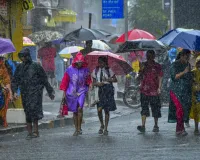New Delhi Railway Station stampede: Heavy load falling on passenger’s head sparks chaos, claiming 18 lives

A high-level committee investigating the devastating stampede at New Delhi railway station on February 15 has submitted its findings, revealing the root cause of the tragedy that led to the deaths of 18 people. Railway Minister Ashwini Vaishnav shared the report’s conclusions during a session in the Rajya Sabha, shedding light on what triggered the panic.
The incident: When a falling load triggered panic
According to the report, the stampede occurred around 8:48 pm on the stairway of Foot Over Bridge-3, which connects platforms 14 and 15. At that time, a large crowd of pilgrims was gathered at the station, waiting to board trains bound for Prayagraj. Many passengers were carrying heavy, bulky luggage on their heads while trying to navigate the crowded stairway.
Suddenly, a piece of heavy baggage slipped and fell from a passenger’s head, causing immediate confusion and distress. This triggered a sudden surge and pressure on the narrow stairway, resulting in people losing balance and falling over each other, which escalated into a tragic stampede.
Crowd dynamics and location limits
The report clarifies that the chaos remained confined to the stairway connecting platforms 14 and 15 and did not spread further across the station. However, the crowded conditions, combined with passengers carrying heavy loads, created an environment where a single accident quickly led to panic and loss of control.
Context and consequences
At the time of the incident, the station was heavily crowded with pilgrims travelling for religious purposes, further complicating movement. This tragic event highlights the challenges of managing large crowds with limited infrastructure and the dangers posed when luggage and passenger safety are compromised.
Steps forward
Officials have emphasised the need for improved crowd management, better monitoring of passenger loads, and enhanced safety protocols on platforms and footbridges to prevent such disasters in the future. The findings from this high-level inquiry will guide policy changes and operational improvements at major railway hubs across India.
About The Author
Welcome to Aryan Age, an English newspaper that has been serving readers since 2011 from Delhi. With a loyal circulation of over 19,000, we are dedicated to providing our readers with the latest news and information, as well as insightful analysis and commentary that help them navigate the complex and rapidly changing world.










Comment List